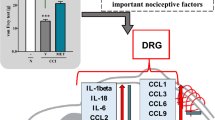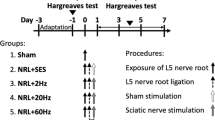Abstract
Purpose
TNFα is an inflammatory mediator related to neuropathic pain including sciatica. Much basic research suggests that anti-TNFα therapy may be useful for the treatment of sciatica. The purpose of this study was to clarify the effects of etanercept in a dorsal root ganglion (DRG) compression model.
Methods
Adult male Sprague-Dawley rats (200–250 g, n = 60) were used. An L-shaped stainless rod was used to compress the left L5 DRG in the saline and etanercept groups. No rod was used in the sham group. In the etanercept group, 1 mg of etanercept was applied locally onto the DRG at the end of surgery. Saline was applied in the saline and sham groups. On day 3 and day 7 after surgery, the number of ED1-immunoreactive (IR) cells (macrophages) in the DRG was calculated by immunohistochemical methods (n = 6). In addition, double-immunofluorescence labeling for ED1 and TNFα was performed. Behavioral testing with von Frey filaments and a heat stimulator was performed (n = 12).
Results
ED1-IR cells in the DRG significantly increased in the control group compared with the sham group (p < 0.05). Some ED1-IR cells were co-labeled for TNFα. In the etanercept group, decrease in mechanical threshold was significantly inhibited compared with the saline group (p < 0.05). Thermal hyperalgesia was observed in the control group, but in neither the sham nor etanercept group (p < 0.05).
Conclusion
Etanercept attenuated the pain-related behavior induced by DRG compression. These findings suggest that mechanical effects on the DRG might be reduced by etanercept in addition to the effects on nucleus pulposus in lumbar disc herniation.





Similar content being viewed by others
References
Abbadie C, Lindia JA, Cumiskey AM et al (2003) Impaired neuropathic pain responses in mice lacking the chemokine receptor CCR2. Proc Natl Acad Sci 100:7947–7952
Catrina AI, Trollmo C, af Klint E et al (2005) Evidence that anti-tumor necrosis factor therapy with both etanercept and infliximab induces apoptosis in macrophages, but not lymphocytes, in rheumatoid arthritis joins: extended report. Arthritis Rheum 52:61–72
Chaplan SR, Bach FW, Pogrel JW et al (1994) Quantitative assessment of tactile allodynia in rat paw. J neurosci methods 53:55–63
Cohen SP, Bogduk N, Dragovich A et al (2009) Randomized, double-blind, placebo-controlled, dose-response, and preclinical safety study of transforaminal epidural etanercept for the treatment of sciatica. Anesthesiology 110:1116–1126
De Rycke L, Basten D, Foell D et al (2005) Differential expression and response to anti-TNF alpha treatment of infiltrating versus resident tissue macrophage subset in autoimmune arthritis. J Pathol 206:17–27
Fenzi F, Benedetti MD, Moretto G et al (2001) Glial cell and macrophage reactions in rat spinal ganglion after peripheral nerve lesions: an immunocytochemical and morphometric study. Arch Ital Biol 139:357–365
George A, Marziniak M, Schafers M et al (2000) Thalidomide treatment in chronic constrictive neuropathy decreases endoneurial tumor necrosis factor-alpha, increases interleukin-10 and has longterm effects on spinal cord dorsal horn met-enkephalin. Pain 88:267–275
Hargreaves K, Dubner R, Brown F et al (1988) A new and sensitive method for measuring thermal nociception in cutaneous hyperalgesia. Pain 32:77–88
Homma Y, Brull SJ, Zhang JM (2002) A comparison of chronic pain behavior following local application of tumor necrosis factor alpha to the normal and mechanically compressed lumbar ganglia in the rat. Pain 95:239–246
Howe JF, Loser JD, Calvin WH (1977) Mechanosensitivity of dorsal root ganglioa and chronically injured axons: a physiological basis for the radicular pain of nerve root compression. Pain 3:25–41
Hu SJ, Xing JL (1998) An experimental model for chronic compression of dorsal root ganglion produced by intervertebral foramen stenosis in the rat. Pain 77:15–23
Hu P, Mclachlan EM (2002) Macrophage and lymphocyte invasion of dorsal root ganglion after peripheral nerve lesions in the rat. Neuroscience 112:23–38
Igarashi T, Yabuki S, Kikuchi S et al (2005) Effect of acute nerve root compression on endoneural fluid pressure and blood flow in rat dorsal root ganglia. J Orthop Res 23:420–424
Igarashi T, Kikuchi S, Shubayeb V et al (2000) Exogenous tumor necrosis factor-alpha mimics nucleus pulposus-induced neuropathology. Spine 25:2975–2980
Kato K, Liu H, Kikuchi S, Myers RR, Shubayev VI (2010) Immediate anti-tumor necrosis factor-alpha (etanercept) therapy enhances axonal regeneration after sciatic nerve crush. J Neurosci Res 88:360–368
Liu T, Van Rooijen N, Tracey DJ (2000) Depletion of macrophages reduces axonal degeneration and hyperalgesia following nerve injury. Pain 86:25–32
Lu X, Richardson PM (1993) Responses of macrophages in rat dorsal root ganglia following peripheral nerve injury. J Neurocytol 22:334–341
Ma C, Lamotte RH (2005) Enhanced excitability of dissociatied primary sensory after chronic compression of the dorsal root ganglion in the rat. Pain 113:106–112
Miyoshi S, Sekiguchi M, Konno S et al (2011) Increased expression of vascular endothelial growth factor protein in dorsal root ganglion exposed to nucleus pulposus on the nerve root in rats. Spine 36:E1–E6
Mohler KM, Torrance DS, Smith CA et al (1993) Soluble tumor necrosis factor (TNF) receptors are effective therapeutic agents in lethal endotoxemia and function simultaneously as both TNF carriers and TNF antagosists. J Immunol 151:1548–1561
Murata Y, Rydevik B, Takahashi K et al (2004) Macrophage appearance in the epineurium and endoneurium of dorsal root ganglion exposed nucleus pulposus. J Peripher Nerv Syst 9:158–164
Myers RR, Heckman HM, Rodriguez M (1996) Reduced hyperalgesia in nerve-injured WLD mice: relationship to nerve fiber phagocytosis, axonal degeneration, and regeneration in normal mice. Exp Neurol 141:94–101
Ohtori S, Takahashi K, Moriya H et al (2004) TNF-α and TNF-α receptor type 1 upregulation in glia and neurons after peripheral nerve injury. Spine 29:1082–1088
Olmarker K, Rydevik B (2001) Selective inhibition of tumor necrosis factor-alpha prevents nucleus pulposus-induced thrombus formation, intraneural edema, and reduction of nerve conduction velocity: possible implications for future pharmacologic treatment strategies of sciatica. Spine 26:863–869
Olmarker K, Nutu M, Storkson R (2003) Changes in spontaneous behavior in rats exposed to experimental disc herniation are blocked by selective TNF-Alpha inhibition. Spine 28:1653–1642
Onda A, Yabuki S, Kikuchi S (2003) Effect of neutralizing antibody to tumor necrosis factor-alpha on nucleus pulposus-induced abnormal nociresponses in rat dorsal horn neurons. Spine 28:967–972
Otoshi K, Kikuchi S, Konno S et al (2010) The reactions of glial cells and endoneurial macrophages in the dorsal root ganglion and their contribution to pain-related behavior after application of nucleus pulposus onto the nerve root in rats. Spine 35:10–17
Rydevik BL, Myers RR, Powell HC (1989) Pressure increase in the dorsal root ganglion following mechanical compression. Closed compartment syndrome in nerve roots. Spine 14:674–678
Sasaki N, Sekiguchi M, Kikuchi S et al (2011) Effects of asialo-erythropoietin on pain-related behavior and expression of phosphorylated-p38 map kinase and tumor necrosis factor-alpha induced by application of autologous nucleus pulposus on nerve root in rat. Spine 36:E86–E94
Schafers M, Svensson CI, Sommer C, Sorkin LS (2003) Tumor necrosis factor-alpha induces mechanical allodynia after spinal nerve ligation by activation of p38 MAPK in primary sensory neurons. J neurosci 23:2517–2521
Sommer C, Marziniak M, Myers RR (1998) The effect of thalidomide treatment on vascular pathology and hyperalgesia caused by chronic constriction injury of rat nerve. Pain 74:83–91
Sommer C, Schafers M, Marziniak M, Toyka KV (2001) Etanercept reduces hyperalgesia in experimental painful neuropathy. J Peripher Nerv Syst 6:67–72
Song XJ, Hu AJ, Greenquist KW, Zhang J-M, LaMotte RH (1999) Mechanical and thermal hyperalgesia and ectopic neuronal discharge after chronic compression of dorsal root ganglion. J Neurophysiol 82:3347–3358
Sugawara O, Atsuta Y, Iwahara T et al (1996) The effect of mechanical compression and hypoxia on nerve root and dorsal root ganglia: an analysis of ectopic firing using an in vitro model. Spine 21:2089–2094
Tachihara H, Sekiguchi M, Kikuchi S et al (2008) Do corticosteroids produce additional benefit in nerve root infiltration for lumbar disc herniation? Spine 33:743–747
Tobinick E (2010) Perispinal etanercept: a new therapeutic paradigm in neurology. Expert Rev Neurother 10:985–1002
Wagner R, Myers RR (1996) Schwann cells produce tumor necrosis factor alpha: expression in injured and non-injured nerves. Neuroscience 73:625–629
Watanabe K, Konno S, Sekiguchi M (2007) Increase of 200kD-neurofilament immunoreactive afferents in the substantia gelatinosa in allodynic rats induced by compression of the dorsal root ganglion. Spine 32:1265–1271
Zhang JM, Song XJ, LaMotte RH (1999) Enhanced excitability of sensory neurons in rats with cutaneous hyperalgesia produced by chronic compression of the dorsal root ganglion. J Neurophysiol 82:3359–3366
Acknowledgments
The authors thank Satoshi Sato and Rie Shibuya for expert technical assistance.
Conflict of interest
No funds were received in support of this work. No benefits in any form have been or will be received from a commercial party related directly or indirectly to the subject of this manuscript.
Author information
Authors and Affiliations
Corresponding author
Rights and permissions
About this article
Cite this article
Watanabe, K., Yabuki, S., Sekiguchi, M. et al. Etanercept attenuates pain-related behavior following compression of the dorsal root ganglion in the rat. Eur Spine J 20, 1877–1884 (2011). https://doi.org/10.1007/s00586-011-1854-y
Received:
Revised:
Accepted:
Published:
Issue Date:
DOI: https://doi.org/10.1007/s00586-011-1854-y




